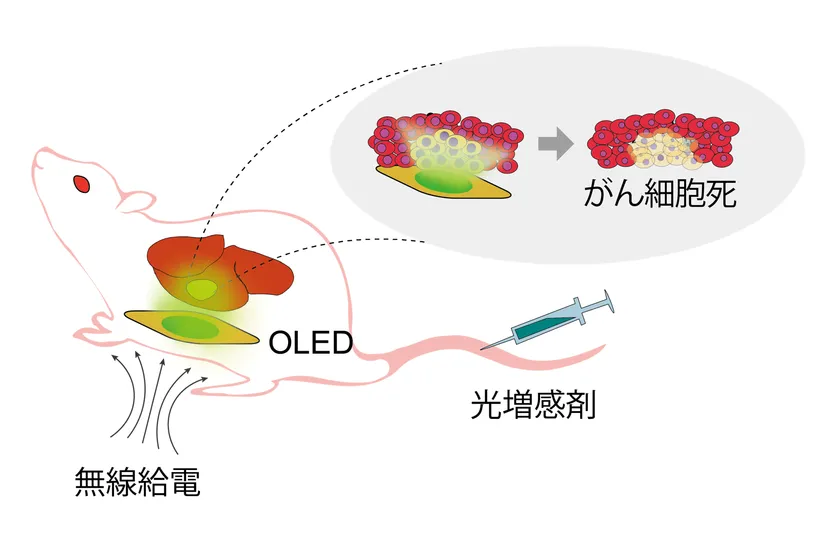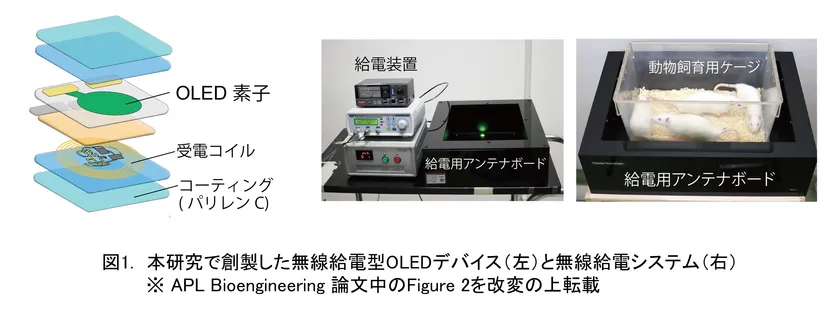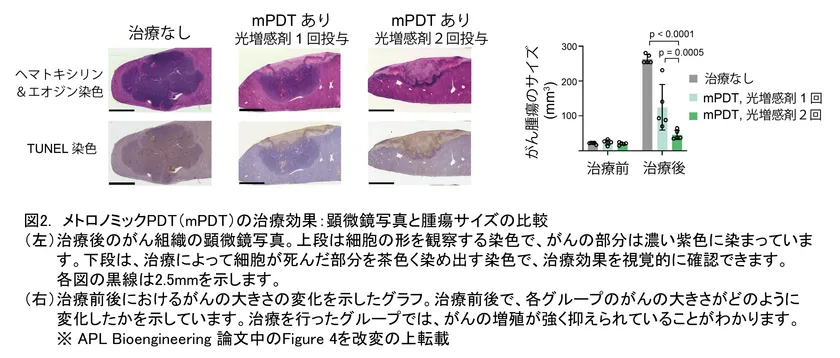OLED (Organic Light Emitting Diode) Driven by Wireless Technology New Optical Cancer Therapy Method ~New treatment approach for deep organ cancer~
National Defense Medical College, Kyushu University, Pleiades Technologies LLC
Dr. Yujiro Itasaki, Professor Yuji Morimoto, and Professor Hiroki Tsujimoto of the National Defense Medical College, in collaboration with Associate Professor Katsuhiko Fujita of Kyushu University, Dr. Kei Sakanoue of Pleiades Technologies, LLC, and their research group, have developed a metronomic photodynamic therapy (mPDT) technique using an in-vivo wireless OLED device for deep organ cancer.

Conceptual diagram of the new photodynamic cancer therapy
This new technology induces sustained killing of cancer cells by administering a photosensitizing agent and irradiating the tumor with extremely low intensity light (<1 mW/cm2) for several days, without the risk of thermal damage. In a rat liver cancer model, significant shrinkage and complete disappearance of cancer was observed with mPDT combined with repeated administration of photosensitizers. In particular, the use of red-emitting OLEDs was shown to extend the effect to the deep and peripheral areas of the tumor. This technology is an important step toward the establishment of next-generation PDT for deep organ cancer.
This research was supported by Grant-in-Aid for Scientific Research (KAKENHI), Japan Science and Technology Agency (JST), Fukuda Foundation for Medical Technology, Uehara Memorial Life Science Foundation, Suzuki Kenzo Foundation, Takeda Foundation for Science Promotion, Tateishi Science and Technology Foundation, Fukuoka Financial Group Corporate Development Foundation provided support for the project.
Drs. Takasumi Tsunenari and Takao Sugihara of the National Defense Medical College, Dr. Kirino Izumi of Kyoto University, Kazuhiro Eguchi and Yutaka Miyazono of Pleiades Technologies, LLC, Ryoichi Yamaguchi of the Kumamoto Prefectural Industrial Technology Center, Kenji Kuwada, Naoki Kobayashi, Tsuyoshi Goya, Katsuyuki Morii of Nippon Shokubai Co..
The research results were published in the US scientific journal APL Bioengineering on April 30, 2025 (Open Access). The research results were also selected as a Noteworthy Paper from the papers published by AIP Publishing (American Institute of Physics Publishing), and published as an article.
The main points of the publication are as follows.
1. A fully implantable wireless OLED (Organic Light Emitting Diode)[*3] device has been developed for metronomic PDT (mPDT)[*2], a type of photodynamic therapy (PDT)[*1], targeting deep organ cancer.
2. The combination of ultra-thin and flexible OLED and wireless power supply technology has realized stable and uniform light irradiation inside the body for a long period of time.
3. The device has been confirmed to significantly improve therapeutic efficacy by repeatedly administering a photosensitizing agent while minimizing thermal damage to normal tissues and immune response.
4. This new minimally invasive treatment method for deep organ cancer is expected to be applied clinically in the future.
Background and history of the research
Photodynamic therapy (PDT) [*1] is a treatment method in which a photosensitizing agent (photosensitive substance) [*4] is accumulated in the target tissue and irradiated with light from outside to generate reactive oxygen species to selectively kill cancer cells. In recent years, metronomic PDT (mPDT)[*2], in which extremely low-intensity light is irradiated for a long period of time, has been proposed and is attracting attention as a new minimally invasive treatment for cancer.
However, in order to apply mPDT to cancers in deep organs, it was necessary to overcome technical challenges such as uniform light irradiation over the entire tumor, maintaining stable light output inside the body, and avoiding thermal damage and immune reaction. In particular, conventional light sources (lasers) have limitations in terms of miniaturization and flexibility, making it difficult to fully embed them in the body and apply them to deep organs.
Research Details
In this research, we have developed a new fully implantable light therapy device that can provide stable and uniform light irradiation to cancers in deep organs. The device is equipped with an organic light-emitting diode (OLED)[*3] device 0.1 mm thick and can emit green or red light from a light-emitting surface 8 mm in diameter. Combined with wireless power supply technology, continuous irradiation with constant light intensity is possible even when the animal is free to move (Figure 1).
In an experiment using a rat liver cancer model, the device was implanted on the tumor surface and irradiated continuously for up to four days after administration of the photosensitizing agent temoporfin. As a result, marked shrinkage and tissue necrosis of the tumor were observed, especially in the condition where the photosensitizer was administered twice, the tumor volume was reduced to 14% of the control group (Figure 2).
Furthermore, the red OLEDs reached deeper into the tumor than the green OLEDs and showed superior therapeutic efficacy over a wider vertical and horizontal area of the tumor. In safety evaluations, no changes in body weight or elevations in liver enzymes (an indicator of liver damage) were observed, and no significant side effects were identified. In addition, coating the device with Parylene C to enhance biocompatibility minimized the formation of fibrous capsules associated with immune response.
Future Developments
This study has established the basis for a new metronomic PDT system that can be safely and effectively applied to deep organ cancers. In the future, by integrating the device with an external portable power supply, we are considering the realization of "home-based metronomic PDT," in which patients themselves lead their daily lives while receiving treatment. In addition, as the device becomes even smaller and more flexible, it is expected to be applied to organs with complex shapes, such as the gastrointestinal tract, respiratory organs, and urinary organs.
In addition, the detailed mechanisms of metronomic PDT, such as the optimal dosing interval of photosensitizers and their effects on the cancer microenvironment, are expected to lead to the development of personalized therapies. This technology is strongly expected to be applied clinically in the future, as it offers a completely new treatment option for refractory cancers in deep organs that have been difficult to treat in the past.

Figure 1

Figure 2
Terminology
*1. Photodynamic therapy (PDT)
Photodynamic therapy (PDT) is a treatment method in which a photosensitizing agent [*4] that selectively accumulates in cancer cells is administered to the body, and by irradiating the tissue with light of a specific wavelength, active oxygen is generated and cell death is induced. Since it can target cancerous tissue, it causes little damage to normal tissue and is attracting attention as a minimally invasive treatment. In Japan, it has been clinically applied to lung cancer, esophageal cancer, and brain tumors.
*2. Metronomic PDT
Metronomic PDT (mPDT) is a new photodynamic therapy technique that delivers extremely low-intensity light (<1 mW/cm2) for a longer period of time compared to conventional PDT. It is believed that continuous treatment with weak light can inhibit tumor growth while reducing the risk of thermal damage, and is expected to be applied to deep organ cancer. The miniaturization and implantation of devices are enabling continuous light irradiation deep inside the body, which has been difficult to achieve in the past.
*3. OLED (Organic Light Emitting Diode)
OLED (Organic Light Emitting Diode) is a device that uses an organic compound to emit light using an electric current and is widely known as a display technology for smartphones and televisions. In medical applications, OLEDs are attracting attention as light source devices with excellent adhesiveness to living tissues and ease of implantation, taking advantage of their thin, lightweight, and flexible characteristics. In this study, the device is used as a light therapy device that is implanted in the body to continuously irradiate tumors with low-intensity light.
*4. photosensitizers (light-sensitive substances)
Photosensitizers (photosensitive substances) are substances that selectively accumulate in target tissues, such as cancer cells, after being administered into the body and produce reactive oxygen species when exposed to light of a specific wavelength. The basic principle of photodynamic therapy (PDT) is that these reactive oxygen species are cytotoxic and kill tumor cells. The photosensitizers that can be used clinically in Japan are sodium thalaporphine and sodium porphymer, and it is important to develop light-emitting devices that are compatible with the wavelength of the light to be irradiated.
Summary of about 100 words
Using a flexible implantable wireless OLED device, we have successfully demonstrated the high therapeutic efficacy and safety of metronomic photodynamic therapy, which is a low-intensity and long-duration light irradiation for deep organ cancer. This paved the way for the clinical application of next-generation photodynamic therapy.
Journal name: APL Bioengineering (Open Access)
Title of paper: Metronomic photodynamic therapy for deep organ cancer by implantable wireless OLEDs.
Author: Yujiro Itazaki, Kei Sakanoue, Katsuhiko Fujita, Izumi Kirino, Kazuhiro Eguchi, Yutaka Miyazono, Ryoichi Yamaguchi, Takasumi Tsunenari, Takao Sugihara, Kenji Kuwada, Naoki Kobayashi, Tsuyoshi Goya, Katsuyuki Morii, Hironori Tsujimoto, Yuji Morimoto
DOI: 10.1063/5.0256898
This study has been selected as a remarkable paper among the papers published by AIP Publishing (American Institute of Physics Publishing), and the related article has been published in "Scilight", an online content introducing the study as an article for the general public.
Article title: Wireless OLED metronomic photodynamic device kills deep organ tumor cells in rat model
DOI: 10.1063/10.0036667
- Category:
- Technology & Development
- Genres:
- Medical care Technology Economy(Japan)



